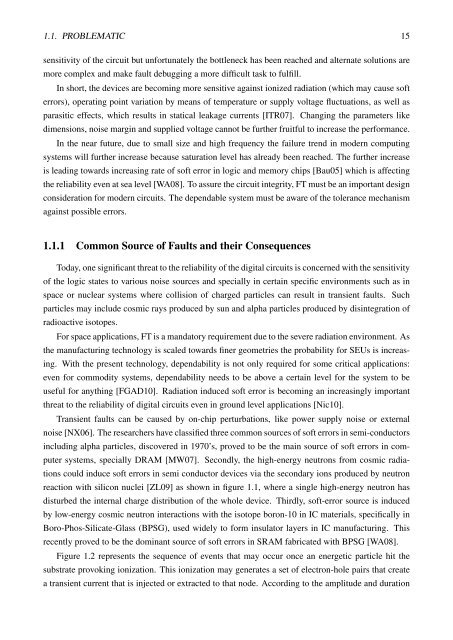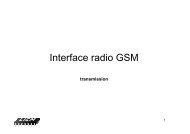Dependable Memory - Laboratoire Interface Capteurs ...
Dependable Memory - Laboratoire Interface Capteurs ...
Dependable Memory - Laboratoire Interface Capteurs ...
You also want an ePaper? Increase the reach of your titles
YUMPU automatically turns print PDFs into web optimized ePapers that Google loves.
1.1. PROBLEMATIC 15<br />
sensitivity of the circuit but unfortunately the bottleneck has been reached and alternate solutions are<br />
more complex and make fault debugging a more difficult task to fulfill.<br />
In short, the devices are becoming more sensitive against ionized radiation (which may cause soft<br />
errors), operating point variation by means of temperature or supply voltage fluctuations, as well as<br />
parasitic effects, which results in statical leakage currents [ITR07]. Changing the parameters like<br />
dimensions, noise margin and supplied voltage cannot be further fruitful to increase the performance.<br />
In the near future, due to small size and high frequency the failure trend in modern computing<br />
systems will further increase because saturation level has already been reached. The further increase<br />
is leading towards increasing rate of soft error in logic and memory chips [Bau05] which is affecting<br />
the reliability even at sea level [WA08]. To assure the circuit integrity, FT must be an important design<br />
consideration for modern circuits. The dependable system must be aware of the tolerance mechanism<br />
against possible errors.<br />
1.1.1 Common Source of Faults and their Consequences<br />
Today, one significant threat to the reliability of the digital circuits is concerned with the sensitivity<br />
of the logic states to various noise sources and specially in certain specific environments such as in<br />
space or nuclear systems where collision of charged particles can result in transient faults. Such<br />
particles may include cosmic rays produced by sun and alpha particles produced by disintegration of<br />
radioactive isotopes.<br />
For space applications, FT is a mandatory requirement due to the severe radiation environment. As<br />
the manufacturing technology is scaled towards finer geometries the probability for SEUs is increas-<br />
ing. With the present technology, dependability is not only required for some critical applications:<br />
even for commodity systems, dependability needs to be above a certain level for the system to be<br />
useful for anything [FGAD10]. Radiation induced soft error is becoming an increasingly important<br />
threat to the reliability of digital circuits even in ground level applications [Nic10].<br />
Transient faults can be caused by on-chip perturbations, like power supply noise or external<br />
noise [NX06]. The researchers have classified three common sources of soft errors in semi-conductors<br />
including alpha particles, discovered in 1970’s, proved to be the main source of soft errors in com-<br />
puter systems, specially DRAM [MW07]. Secondly, the high-energy neutrons from cosmic radia-<br />
tions could induce soft errors in semi conductor devices via the secondary ions produced by neutron<br />
reaction with silicon nuclei [ZL09] as shown in figure 1.1, where a single high-energy neutron has<br />
disturbed the internal charge distribution of the whole device. Thirdly, soft-error source is induced<br />
by low-energy cosmic neutron interactions with the isotope boron-10 in IC materials, specifically in<br />
Boro-Phos-Silicate-Glass (BPSG), used widely to form insulator layers in IC manufacturing. This<br />
recently proved to be the dominant source of soft errors in SRAM fabricated with BPSG [WA08].<br />
Figure 1.2 represents the sequence of events that may occur once an energetic particle hit the<br />
substrate provoking ionization. This ionization may generates a set of electron-hole pairs that create<br />
a transient current that is injected or extracted to that node. According to the amplitude and duration



